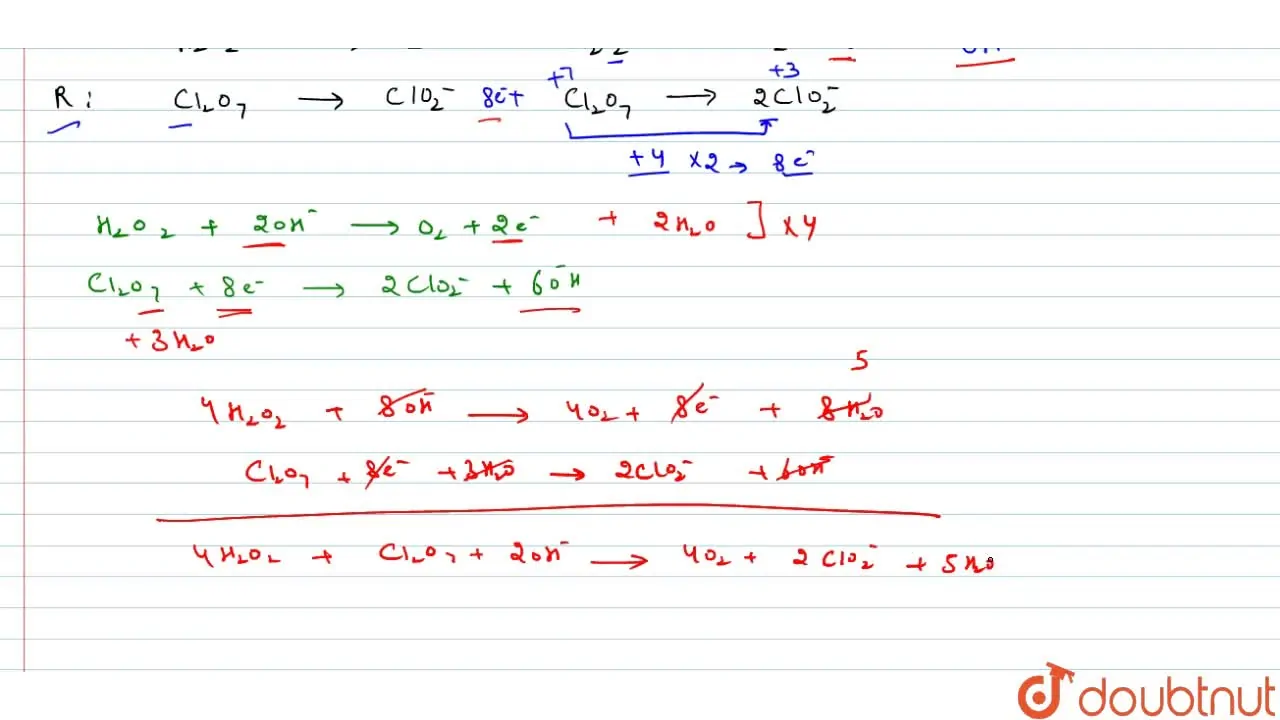Balance the following equations in basic medium by ion-electron method and oxidation number methods and identify the oxidising agent and the reducing agent.
(a)
(b)
(c)

acts both as an oxidising as well as a reducing agent
Oxidation number method
total decrease in O.N of in
total increase in O.N of In
therefore to balance increase / decreases in O.N multiply by 1 and by 3 we have
(aq)
To balance O atoms multiply by 6 we have
To balance H atoms add to L.H.S and to the R.H.S we have
To
thus equ (i) represent the correct balanced equation
Ion electron method split the given redox reaction in to two half reaction (ii) and (iii) and balance them s described below
To cancel out eletrons multiply Eq (iii) by 3 and add it to q we have
thus eq (vi) represetns the correct balanced equation

oxidation number method
total increase in O.N of total decrease in O.N of CI
therefore to balance increase / decrease in O.N multiply by 3 and by 4 we have
oxdation number method
total increase in O.N of total decrease in O. N of
therefore to balance increase / decrease in O.N mutiply by 3 and by 4 have
to balance N and CI atoms multiply NO by 6 and by 4 we have
H atom get automatically balanced and thus eq (i) represent the correct balanced equation
Iron electron method
thus eq (iii) represent the correct balacned reductional half equation
Thus eq (iv) represetn the correct balanced equation

thus (g) acts an oixdising agent while (aq) as the reducing agent
oxidation number method
Total decrease in O.N of 1 total increase in O.N of
To balanced increase / decrease in O.N multiply and by 4 we have
to balance CI atoms multiply by 2 we have
to balance H atoms add
on electron method
oxidation half reaction
balance charge by adding
balance O atoms by adding
reduction half rection
balance O atom s by adding
to cancel out electrons multiply eq (i) by 4 and add it to eq (ii) we have
Related Playlists
- BOOK - PRADEEPCHAPTER - REDOX REACTIONS EXERCISE - NCERT(EXEMPLAR PROBLEMS WITH ANSERS HINTS AND SOLUTION-I)11videos
REDOX REACTIONS
- BOOK - PRADEEPCHAPTER - REDOX REACTIONS EXERCISE - NCERT(EXEMPLAR PROBLEMS WITH ANSERS HINTS AND SOLUTION-II)5videos
REDOX REACTIONS
- BOOK - PRADEEPCHAPTER - REDOX REACTIONS EXERCISE - NCERT (QUESTIONS AND EXERCISES WITH ANSWERS)10videos
REDOX REACTIONS
- BOOK - PRADEEPCHAPTER - P-BLOCK ELEMENTS (NITROGEN FAMILY)EXERCISE - Competition focus jee(main and advanced)/ medical entrance special) (VIII. Assertion-Reason Type Questions)10videos
P-BLOCK ELEMENTS (NITROGEN FAMILY)
- BOOK - PRADEEPCHAPTER - S-BLOCK ELEMENTS (ALKALI AND ALKALINE EARTH METALS) EXERCISE - Assertion -Reason Type Question (Type 2)19videos
S-BLOCK ELEMENTS (ALKALI AND ALKALINE EARTH METALS)
Similar Questions
Balance the following equations in basic medium by ion-electron method and oxidation number methods and identify the oxidising agent and the reducing agent.
(a) P4(s)+OH−(aq)→PH3(g)+HPO−2(aq)
(b) N2H4(1)+ClO−3(aq)→NO(g)+Cl−(g)
(c) Cl2O7(g)+H2O2(aq)→ClO−2(aq)+O2(g)+H+View SolutionBalance the following equations in basic medium by ion-electron method and oxidation number methods and identify the oxidising agent and the reducing agent.
(a) P4(s)+OH−(aq)→PH3(g)+HPO−2(aq)
(b) N2H4(1)+ClO−3(aq)→NO(g)+Cl−(g)
(c) Cl2O7(g)+H2O2(aq)→ClO−2(aq)+O2(g)+H+View Solution(Associativity ) Let f:A→B,g:B→C and h:C→. Then prove that ( h o g) o f = h o ( g o f )
View Solution(Associativity ) Let f:A→B,g:B→C and h:C→. Then prove that ( h o g) o f = h o ( g o f )
View SolutionBalance the equation
As2(s)+NO−3(aq)+H+(aq)→AsO+(4)3−(aq)+S(s)NO(g)+H2O(l)View SolutionBalance the equation
As2(s)+NO−3(aq)+H+(aq)→AsO+(4)3−(aq)+S(s)NO(g)+H2O(l)View SolutionBalance the following reactions by ion electron method : Cl2+OH−→ClO3+Cl+H2O
View SolutionO3(g)+I−(aq)+H2O(l)→
View Solution4M(s)+8CN−(aq)+2H2O(aq)+O2(g)→4[M(CN)2](aq)+4OH−(aq).Here
View Solution4M(s)+8CN−(aq)+2H2O(aq)+O2(g)→4[M(CN)2](aq)+4OH−(aq).Here
View Solution


